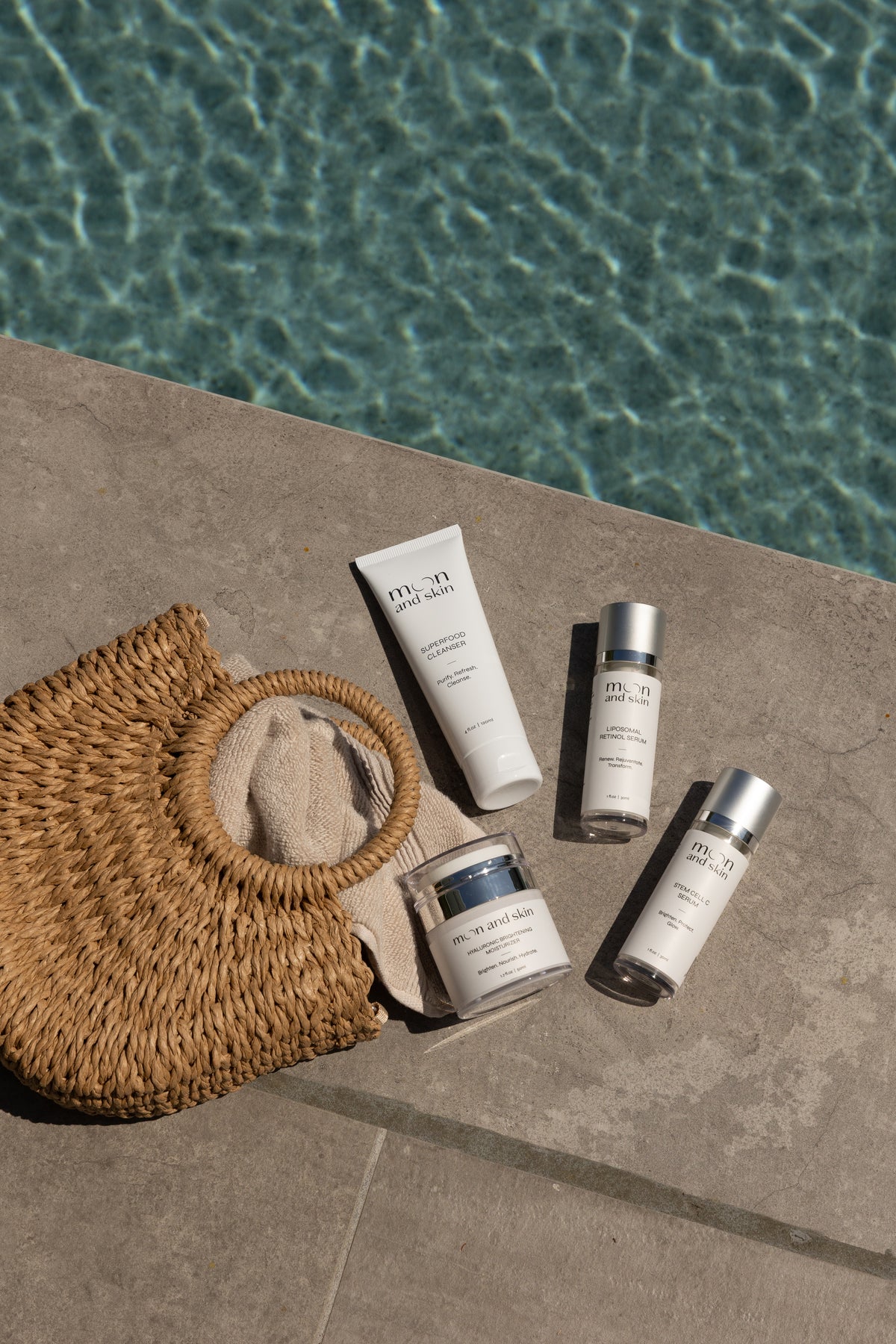Table of Contents
Introduction
Have you ever found yourself standing in front of your bathroom mirror, skincare products lined up like soldiers, wondering just how long your routine should take? You're not alone. In fact, a recent survey revealed that nearly 60% of individuals feel overwhelmed by the time commitment required for an effective skincare routine. With so many products and steps to consider, the question often arises: how long should a skincare routine take?
At Moon and Skin, we understand that navigating the world of skincare can be daunting, especially with the myriad of products and ever-evolving routines. As a brand dedicated to providing clean, thoughtful skincare for every phase of life, we believe that the time you invest in your routine should not only be efficient but also effective. This blog post aims to clarify the ideal duration of a skincare routine, highlighting the importance of each step while empowering you to create a regimen that suits your unique needs.
Together, we'll explore how to balance speed with efficacy, the role of each product, and our commitment to clean, thoughtful formulations. By the end of this post, you’ll have a better understanding of how to streamline your routine while delivering the best results for your skin.
Understanding the Basics of a Skincare Routine
A skincare routine typically includes several key steps: cleansing, toning, treating, moisturizing, and protecting. Each step serves a specific purpose, and the time you allocate can vary based on your skin type, the products used, and your personal skincare goals.
1. Cleansing: The Foundation of Your Routine
Cleansing is the first and arguably the most crucial step in any skincare routine. It sets the stage for the absorption of subsequent products.
- Time Investment: We recommend spending about 1-2 minutes on this step. This allows you to thoroughly cleanse your skin of impurities, excess oil, and makeup.
At Moon and Skin, we offer our Superfood Cleanser, which is designed to nourish while it cleanses, making the process both effective and gentle on your skin.
2. Toning: Balancing Your Skin
Toners help restore your skin's pH balance and prepare it for better absorption of your treatment products.
- Time Investment: Allocating 30 seconds to 1 minute here is usually sufficient. Applying toner can be as simple as spritzing or patting it onto your skin.
3. Treatment: Targeting Specific Concerns
This step is where you can tailor your routine to address specific skin concerns, such as brightening, anti-aging, or hydration.
- Time Investment: Plan for 2-3 minutes to allow treatments like serums to fully absorb into your skin.
Our Stem Cell C Serum is an excellent choice for brightening and protecting your skin. With its stable vitamin C and advanced plant-cell technology, it works effectively to enhance your skin’s natural radiance.
4. Moisturizing: Hydration is Key
Moisturizers help to lock in hydration and create a protective barrier on the skin.
- Time Investment: Spend about 1-2 minutes applying your moisturizer.
Our Hyaluronic Brightening Moisturizer is an excellent choice for adding hydration while brightening your complexion, making it a perfect addition to your routine.
5. Sun Protection: The Final Shield
Finally, applying sunscreen in the morning is essential for protecting your skin from harmful UV rays.
- Time Investment: Allow 1-2 minutes for this step. It's critical to let your sunscreen fully absorb before going outside.
Total Time for a Basic Skincare Routine
When you add up the time for each step, a basic skincare routine should take approximately 5 to 10 minutes. However, if you're incorporating more products or steps, such as exfoliants or masks, this could extend to 15 to 30 minutes.
The Importance of Consistency
The effectiveness of your skincare routine is not solely based on the time spent on each step but also on the consistency of your regimen. Regular application of products leads to better results. We suggest establishing a routine that feels manageable for you—this could mean simplifying steps or selecting products that pack multiple benefits.
Customizing Your Routine Based on Skin Type
Understanding your skin type is vital for customizing your routine effectively. Here’s how to tailor your routine to your unique needs:
1. Oily Skin
For those with oily skin, a lighter routine may be beneficial. Focus on non-comedogenic products and prioritize cleansing and controlling oil production.
- Routine Duration: Approximately 5-10 minutes.
2. Dry Skin
Individuals with dry skin should focus on hydration and moisture retention. This may involve additional steps or products specifically designed to lock in moisture.
- Routine Duration: Approximately 10-15 minutes.
3. Combination Skin
Combination skin requires a balanced approach. Tailor your products to target both dry and oily areas, adjusting as necessary.
- Routine Duration: Approximately 10-15 minutes.
4. Sensitive Skin
If you have sensitive skin, consider minimizing steps and using gentle, soothing products to prevent irritation.
- Routine Duration: Approximately 5-10 minutes.
Layering Products: The Waiting Game
After applying a product, the time you wait before applying the next can significantly influence the effectiveness of your routine. Here’s a breakdown of recommended wait times:
- Hydrating Serums: Apply immediately after cleansing but wait a minute for it to absorb.
- Vitamin C Serum: Wait about 1-2 minutes before layering other products.
- Retinol: Allow 10-20 minutes before applying subsequent products to avoid irritation.
- SPF: Wait at least 15 minutes before heading outdoors.
This waiting period is crucial for allowing active ingredients to penetrate the skin effectively.
The Role of Ingredients in Your Routine
Choosing the right ingredients is essential for achieving your skincare goals. Here are some key ingredients to consider:
1. Vitamin C
Known for its brightening and antioxidant properties, Vitamin C can help protect your skin against environmental stressors while improving overall radiance.
- Time to Effect: You may see immediate brightening effects, but consistent use over 2-3 months is necessary for long-term benefits.
2. Retinol
A powerhouse for anti-aging, retinol can significantly improve skin texture and tone.
- Time to Effect: Expect to see noticeable improvements after 6-12 weeks, but some users may experience initial irritation.
3. Hyaluronic Acid
This hydrating hero draws moisture into the skin, providing immediate plumping effects.
- Time to Effect: You’ll feel the hydration almost instantly, but cumulative use will improve overall skin health.
Conclusion
So, how long should your skincare routine take? The ideal duration can range from 5 to 30 minutes, depending on your specific needs and the products you choose. Ultimately, the goal is to find a balance that allows you to care for your skin effectively without feeling overwhelmed.
At Moon and Skin, we believe that a successful skincare journey embraces each phase of life. By creating a thoughtful routine, you can celebrate your skin's unique qualities and invest in its health.
To optimize your routine, consider our Bundle & Save collection, which combines our best-selling products for a comprehensive skincare experience.
FAQ
Q1: Is it necessary to follow all steps in a skincare routine?
A1: While there are essential steps like cleansing, treating, and moisturizing, you can customize your routine based on your skin type and concerns.
Q2: Can I skip sunscreen on cloudy days?
A2: No, sunscreen should be applied daily, regardless of the weather, as UV rays can penetrate clouds.
Q3: How do I know if my routine is working?
A3: Look for improvements in your skin's texture, tone, and overall health. Consistency is key.
Q4: What should I do if my skin reacts negatively to a product?
A4: Discontinue use immediately and consult with a dermatologist if irritation persists.
Q5: How often should I change my skincare products?
A5: It’s best to stick with a routine for at least a few months to gauge effectiveness. Switch products only if they are not meeting your needs.
By understanding how long your skincare routine should take and tailoring it to your unique needs, you can enjoy the journey of caring for your skin. Let's embark on this journey together!







